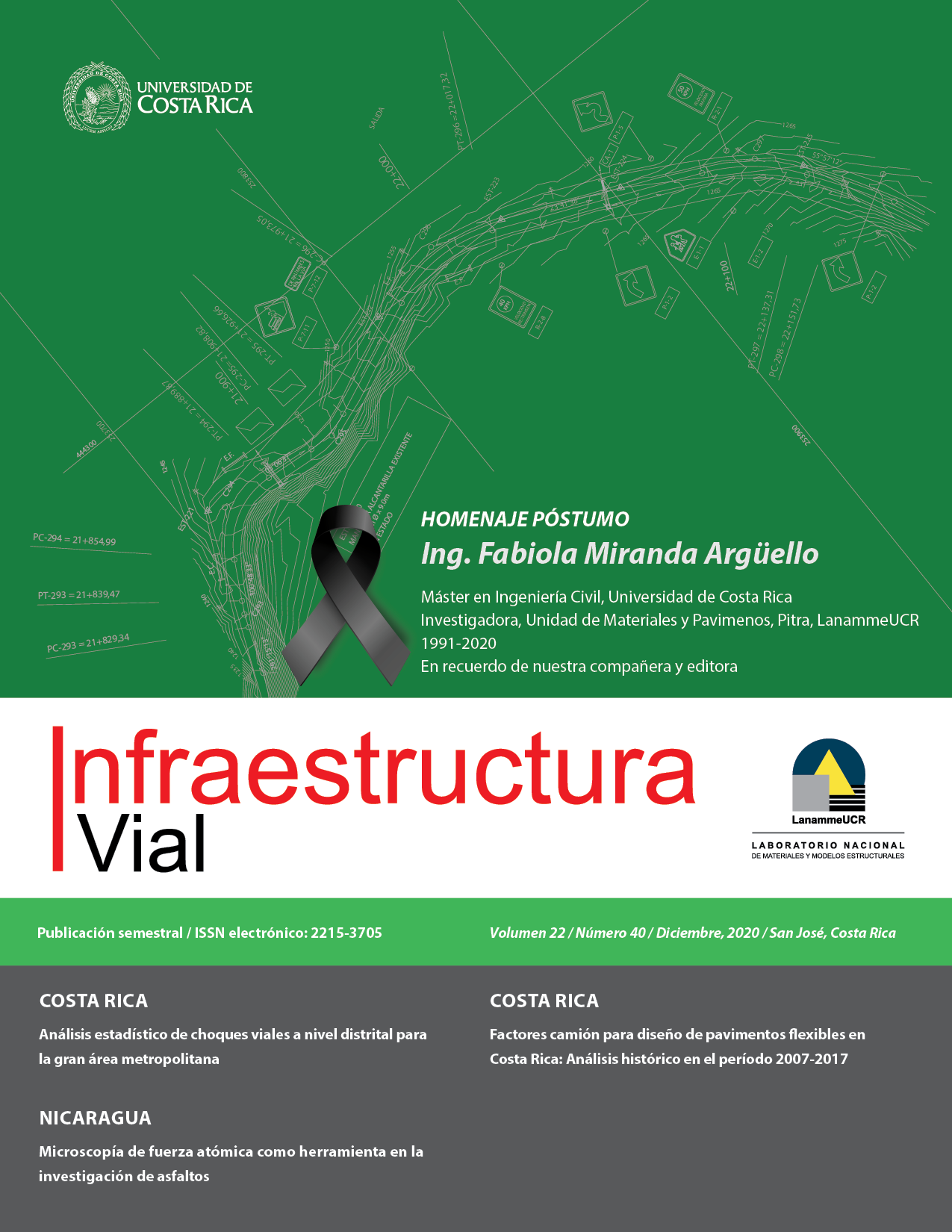Abstract
The Atomic Force Microscope is used to obtain superficial images with high resolution. As well, to acquire information about the mechanical properties of a material. This tool has several operation modes, such as static, dynamic, tapping and contact, among others. It is worth to mention that cantilever has several geometries, then choosing the right one is a crucial step in any investigation that uses AFM. The focus of this article is to give a broad outlook of the AFM, from its operation modes to its applications in asphalt studies. Upon this article, the AFM is highly used in asphalts to analyse the microscopic properties and to understand how these properties impact its macroscopic performance.
References
Abd, D., Al-Khalid, H. y Akhtar, R. (2017). Nano-scale properties of warm-modified bituminous binders determined with atomic force microscopy, Road Materials and Pavement Design, 18(sup2), 189-202. DOI: 10.1080/14680629.2017.1304262
Aguiar, J., Loria, L. y Salazar, J. (2017). Respuesta micromecánica del asfalto mediante AFM. ASFALTO, VII(26), 25-34.
Aguiar, J., Salazar, J., Bonilla, V., Rodríguez, E., Leiva, F. y Loría, L. (2015). Morphological analysis of bitumen phases using atomic force microscopy. Road Materials and Pavement Design, 16(sup1), 138-152. DOI: 10.1080/14680629.2015.1029672
Allen, G., Little, D. y Bhasin, A. (2012). Structural Characterization of Micromechanical Properties in Asphalt Using Atomic Force Microscopy. Journal of Materials in Civil Engineering, 24(10), 1317-1327. DOI: 10.1061/(ASCE)MT.1943-5533.0000510.
Binnig, G., Quate, C. F. y Gerber, C. (1986). Atomic Force Microscope. Physical Review Letters, 56(9), 930-933. DOI: 10.1103/PhysRevLett.56.930
Carrión, V., Valbuena, J. y Gomez, H. (2010). Dispositivo interfase digital para la integración del modo de imagen en espectroscopio de fuerza monomolecular. ES 2 316 285 B1 España: Oficina española de patentes y marcas.
Carvajal, D. F. (2010). Caracterización mecánica de materiales mediante técnicas de microscopía de fuerza atómica y nanoindentación. (Tesis de grado). Colombia, Universidad de Los Andes.
Das, P., Baaj, H., Tighe, S. y Kringos, N. (2016). Atomic force microscopy to investigate asphalt binders: a state-of-the-art review. Road Materials and Pavement Design, 17(3), 693-718. DOI: 10.1080/14680629.2015.1114012
García, A. (2017). Análisis del comportamiento micromecánico del asfalto. Revista Infraestructura Vial, 18(31), 39-45. DOI: 10.15517/IV.V18I31.27763
García, A. (2018). Implementación de metodología para estimación del módulo de elasticidad de asfalto mediante microscopía de fuerza atómica. (Tesis de Maestría). Ciudad Universitaria Rodrigo Facio, Costa Rica.
García, A., Aguiar, J., Salazar, J., Baldi, A. y Loría, L. (2019). Methodology for estimating the modulus of elasticity of bitumen under different aging conditions by AFM. Road Materials and Pavement Design, 20(SUP1), S332-S346. DOI: 10.1080/14680629.2019.1588152
Gong, M., Zhu, H., Pauli, T., Yang, J., Wei, J. y Yao, Z. (2017). Evaluation of bio-binder modified asphalt’s adhesion behavior using sessile drop device and atomic force microscopy. Construction and Building Materials, 145, 42-51. DOI: 10.1016/j.conbuildmat.2017.03.114
Haugstad, G. (2012). Atomic Force Microscopy: Understanding Basic Modes and Advanced Applications. Hoboken, NJ: John Wiley & Sons, Inc.
Kyeyune, B. (2017). Atomic Force Microscopy. (Tesis de maestría). Tanzania: African Institute for Mathematical Sciences.
Meyer, E. y Amer, N, M. (1988). Novel optical approach to atomic force microscopy. Applied Physics Letters, 53, 1045. DOI: 10.1063/1.100061
Nanoworld (2020). AFM probes. Recuperado de https://www.nanoworld.com
Olmos, D. y Gonzalez, B. (2009). Microscopia de fuerza atómica. Práctica 1. Modos básicos de operación. Universidad Carlos III de Madrid.
Olmos, D. (2009). Microscopía de efecto túnel y microscopía de fuerza atómica. Universidad Carlos III de Madrid.
Raghavan, D., VanLandingham, M., Gu, X. y Nguyen, T. (2000). Characterization of hetero geneous regions in polymer systems using tapping mode and force mode atomic force microscopy. Langmuir, 16(24), 9448–9459. DOI: 10.1021/la991694w
Rahmad, S., Yusoff, N., Rosyidi, S., Haji, K. y Widyatmoko, I. (2020). Effects of Rediset on the adhesion, stripping, thermal and surface morphologies of PG76 binder. Construction and Building Materials, 241, 1-12. DOI: 10.1016/j.conbuildmat.2019.117923
Reséndiz, M. y Castrellón-Uribe, J. (2005). Microscopio de Fuerza Atómica. Encuentro de Investigación en Ingeniería Eléctrica, Zacatecas.
Roa, J., Oncins, G., Díaz, J., Sanz, F. y Segarra, M. (2011). Calculation of Young’s Modulus Value by Means of AFM. Recent Patents on Nanotechnology, 5(1), 27-36. DOI: 10.2174/187221011794474985
Sánchez, J. (2018). Espectroscopía de Fuerzas Multidimensional para la Caracterización en la Nanoescala de las Interacciones Electrostática y de Dispersión. (Tesis doctoral). España: Universidad de Murcia.
Yang, J., Zhu, X., Yuan, Y. y Li, L. (2020). Effects of Aging on Micromechanical Properties of Asphalt Binder Using AFM. Journal of Materials of Civil Engineering, 32(5), 04020081. DOI: 10.1061/(ASCE)MT.1943-5533.0003030.


